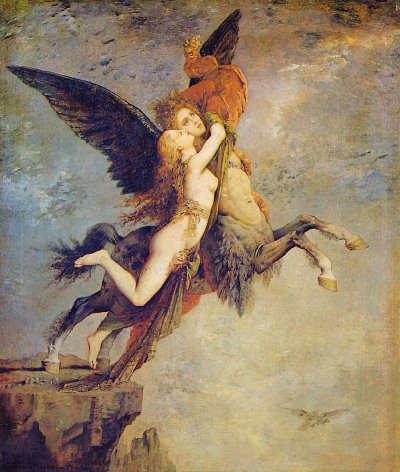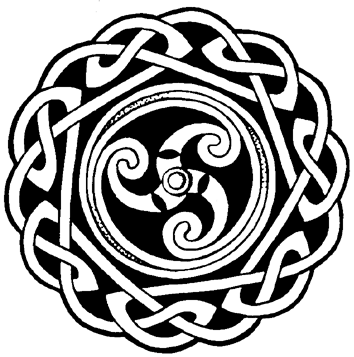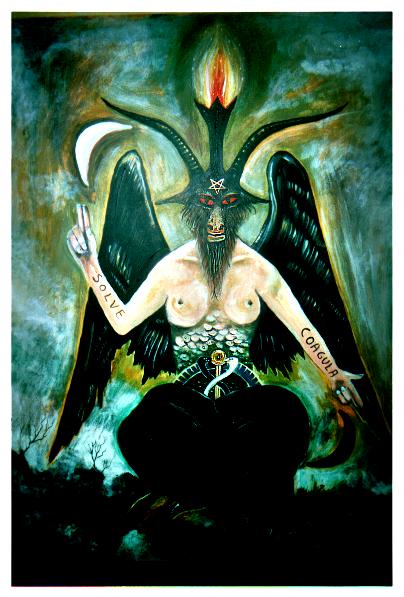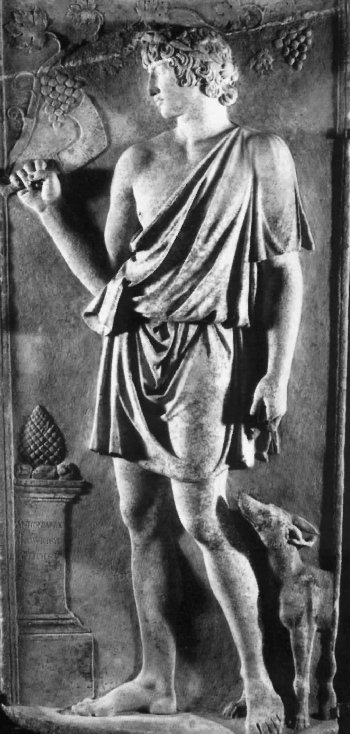| Witches & Pagan Religious Practices
The Gothic eZine - Pagan Witchcraft
Witches, their Magick, and arcane religious practices of Pagan EuropeA Brief History of Old Europe Perhaps as many as 20,000 years ago, the Indo-European-speaking peoples migrated from their mythical homeland of the north pole to escape the winter of the ice age. This group, with its languages which would eventually evolve into most modern European languages, spread through the European land mass from Russia to Ireland. The Celtic subfamily of Indo-European provided the basis not only for modern languages such as Welsh, Breton and Gaelic, but also probably linked earlier groups of Celtic speakers across much of western Europe. The people from whom the Celts likely derived, at least in part, was the group which occupied the northern Alpine regions of Europe, a people known by their burial rites as the Urnfield group. The agricultural, bronze-using Urnfields, who can be thought of as proto-Celts, existed from roughly 1300-700 B.C.E.. They were succeeded by the Hallstatt culture around 700-600 B.C.E., which is distinguished by the use of iron and a change in burial practices. Around 500 B.C.E., the La Tene culture appeared, signifying a shift of power within the loci of Celtic groups, as well as important contacts of trade and artistic production. At this point there are obvious influences of the Mediterranean world in Celtic art and metalwork; presumably, Mediterranean ideas and mythologies also found their way westward. After about 450 B.C.E. the Celts began aggressively expanding, moving south into the Italic peninsula as far as Rome, into Asia Minor and Macedonia, and westward into Gaul and the British Isles. In addition, the Celts mingled with the Teutonic speakers west of the Rhine. Although after about 279 B.C.E. the Celts began retreating back into western Europe, it is clear from this abbreviated account that the Celts in their travels would have had extensive contact with the peoples and ideas of the Mediterranean, eastern European, Teutonic/Germanic and Greco-Roman world. It is likely that elements of these other systems of worship merged with or influenced the religion of the Celts. The Romans were particularly influential in this respect. A combination of Gaulish settlers and Roman conquerors contributed to the Romanization of several Celtic deities in the British Isles; however, the importance of Celtic contact with both the Germanic and Mediterranean world should not be understated. Considering the heterogeneity and geographic diversity of the Celtic peoples, it is probable that the Celtic religion is highly syncretic. The Romans remained in the south of Britain while several barbarian tribes such as the proto-Picts roamed the north. This created within Roman Britain what Ross calls a "dichotomy [that was] economic, social and spiritual..." between the Roman institutions and the "native cults" created by the Celtic tribes. Thus, "it is against such a background that we must envisage pagan Celtic religion operating..."
The Horned God Miranda Green in The Sun-Gods of Ancient Europe states that the worship of a sun-deity was a fairly widespread phenomenon in Neolithic and Bronze Age Europe. According to her, the worship of the sun was associated with the worship of the phallus, for both the sun and phallus are capable of fertilization. The sun metaphor is used by many peoples to encompass the ideas of life, death, and the cyclical nature of agrarian time. It is a powerful chthonic force associated with both bringing life and taking it away. Often the sun is depicted as a wheel, its turns marking the seasons of life. The circles of standing stones which dot Britain are likely sun-linked worship sites. Stonehenge is the most famous of these early solar temples, and Green notes: "There is no doubt that the axis of the Early Bronze Age bluestone and sarsen settings of circles and horseshoes was deliberately... pointed to... the sunrise on the longest day of the year." The symbols used to depict the sun are varied across Europe and the Mediterranean, ranging from crosses to swastikas to wheels. More importantly for this essay, the sun is also associated with stag or bovine horns; the horns are combined with a sun symbol or drawn so that the horn tips meet, suggesting the circle and rays of the sun. Perhaps the form of the horns or antlers suggested to the early artist the form of the sun-disk, or perhaps the seasonal shedding of the stag?s antlers provided a metaphorical connection between the seasons and the animal. The horned-sun is not only European but associated with sky-cults in Greece and the rosette-headed bulls of Minoan depiction. There appears to be a link here between the worship of the sun-god and the later horned god of the Celtic pantheon. Horns are juxtaposed with sun-wheels on Iron Age helmets, and on an Iron Age coin, the antlered head of a deity appears with the sun-wheel between his antlers. In addition, there is a likely connection between worship of the sun-cross and later Christianity. Although the sun-deity was not always male, for: "...the Celts recognized the sun as having a strong fertility element and not, therefore, the sole prerogative of a male deity", and although female figurines have been found stamped with sun symbols, the dynamic European sun-deity eventually became linked for the most part with a horned male god. The European cult of the horned god appeared throughout Celtic territory. The earliest evidence for the cult is a 4th century B.C.E. rock carving of a horned deity accompanied by a smaller phallic figure. It seems highly probable that a horned-god cult was established long before the occupation of the Romans in Britain, but merged with the the horned deity, imported from Gaul, who is now known generally as Cernunnos (from cernu, or "horn"). Thus much of what is known of this horned god in Britain has been modified. Scotland and Ireland were more resistant to Roman influence, and seem to have preserved more of the phallic and aggressive elements of the early horned deity. In the northen reaches of Britain the horned god was often depicted more as a warrior than as a fertility deity. The Cornavii tribes who inhabited present-day Caithness, Scotland were known as "People of the Horn" or "Horned Ones". Evidence of the horned god cult in Ireland is found in both literature and art. In the Coir Anman and the Dindshenchas, the horned god may appear as Furbaide Ferbend, "Furbaide the Horned". In addition: "The iconography of Ireland... bears convincing witness to the presence in Ireland of a god-type similar to the Gaulish Cernunnos." Clearly although he may manifest himself in different ways, the horned deity exists as a basic Celtic god-type discernible everywhere. The particular characteristics attributed to the horned male deity who is known generally as Cernunnos vary, but his fundamental role does not change. Essentially he exists as a dynamic principle of fertility linked to both the upper- and underworld, although his sphere of influence also includes fiscal prosperity and commerce; he was likely combined with the Gallic underworld ancestor god Dis Pater who controlled similar areas. He is often depicted as anthropomorphic, with stag or bull?s horns, ram-headed serpents, and in a squatting or crouching position. The prominence of the ram-headed serpents indicates his connection to the underworld as well as to a goddess, although he is almost never seen with a consort. He is sometimes depicted as three-headed or three-horned, which parallels the common Celtic motif of the triple goddess. The Celtic serpent is often also linked to war, and Cernunnos (sometimes known in this aspect by his Celtic name of Belatucadros) wrapped in his serpents may be indistinguishable from the Roman war-god Mars. Although not specifically related to a horned deity, Germanic serpents were worshipped as the source of wisdom and supernatural knowledge, and this reminds us of Cernunnos? shamanic and chthonic role. In addition, the snake was often used as a metaphor for cyclical time both because of its ability to form an endless circle, and its periodic shedding of skin. It seems an apt symbol for a god of the earth and the cycle of the seasons.
In his capacity as protector of the herds and flocks, Cernunnos is connected to the Roman Mercury; in this aspect he appears with beard, horns, phallic symbols and sometimes a caduceus-like object, but minus Mercury?s associative animals (the cock and tortoise). It is interesting that early Christian depictions of Jesus show him as a young shepherd. What is more, Cernunnos and his ram-headed serpents can be linked to the Greek Hermes, a reference to Cernunnos? chthonic liminality. In the eastern forested regions of Britain, Cernunnos is known as Herne or Silvanus and appears as a naked phallic hunter, perhaps linked to the Greek god Pan or the Norse vegetation deity Vidarr. It is this manifestation of Cernunnos which is the most chthonic and perhaps the earliest, for it represents the god in his most primal and phallic form, untamed by the arts of war or civilization. In a similar fashion, the ancient Estonians produced elk-headed figurines, and their modern rural descendants believe that the forest functions as a personification of the part of life which is chaotic and uncontrollable, a place of both good and evil spirits. In addition, the Estonian fertility rites, which take place on St. John?s Eve, consist of parading a straw doll (named "Frey", meaning "master" or "seed") with an enormous phallus through the village before placing it in a forest tree. Dionysian ecstasies take place within the forest, and the Basque legends speak of the "basajaunak", unusually strong and shaggy beings who are the "lords of the wood", and who once possessed the seeds of agriculture. Clearly across Europe and particularly within Celtic territory the horned fertility god represents an important principle of uncontrollable fertility and life force. "It is self-evident that his potency, the longevity of his cult, and his concern for fecundity, both human and animal, would make him most liable to ecclesiastical censure." This is the horned god who Murray believes was worshiped by the so-called "witches" in her book The Witch Cult in Western Europe. After all: "Several other unusual and emphatically non-Christian reliefs from the same site lead to the supposition that pagan symbols, if not actual pagan rites, continued to be known [in the British isles] long after Christianity had established itself." According to Starhawk: "The image of the Horned God was deliberately perverted by the medieval Church into the image of the Christian Devil."
|
|

The Goddesses Recent discoveries push the origins of human psychomental development further back than was originally thought. The lunar cycle was: ...analyzed, memorized, and used for practical purposes some 15,000 years before the discovery of agriculture. This makes more comprehensible the considerable role of the moon in archaic mythologies, and especially the fact that lunar symbolism was integrated into a single system comprising such different realities as woman, the waters, vegetation, the serpent, fertility, death, rebirth, etc. The correlation between the monthly menstrual cycles of women and the monthly birth and death of the moon must have been noticed at a very early stage of human development. Moreover, the female capacity to (apparently) create life unassisted was an obvious metaphor for the creation of all humans. It is no surprise, then, that just as the sun/stag was linked to the fertile male principle, the moon/earth was linked to the fecundity of the female. The original female deity was likely a chthonic goddess of the earth whose body was the land, such as the later Celtic earth-mother goddess Danu, from whom the pantheon of Irish Celtic gods were said to have descended. Most later Celtic goddesses retain this maternal chthonic aspect and the link to the land. As a result, holy places dedicated to goddesses were deliberately located in sacred groves, near rivers, wells or streams, or on hilltops. Celtic goddesses were also shape-shifters and could become animals at will. There is a multitude of Celtic goddesses in the pantheon but for the purpose of brevity we will look at only the ones which seem the most relevant. Goddesses are frequently tripled, signifying the cycle of life, the ages of women (maiden, mother, crone), and the seasonal change of the land. Starhawk notes: "The nature of the goddess is never single." The sea-goddess Marian is linked with the moon-goddess Mari, known also as the Russian enchantress Marena, or the Basque chthonic earth-goddess Mari, who is a bovine goddess. She may be linked etymologically to the triple war-goddess known as the Morrigan. According to Ross: The Morrigan was one of a trio of war goddesses who appear in Irish tradition, influencing the outcome of battle by magic... Possessing marked sexual characteristics, and appearing frequently in ornithomorphic or animal guise, this powerful group of goddesses reveals convincingly all the qualities and attributes suggested by the iconography and epigraphy. Appearing at one moment as terror-inspiring hags, at the next as beautiful young women, and yet again as beaked crows or ravens, these goddesses figure with impressive frequency throughout the earliest stratum of Irish mythological tradition. "Ceridwen [was] one of the forms of the Celtic goddess, and her cauldron [was] the womb-cauldron of rebirth and inspiration." She was also a triple goddess associated with sows and thus the underworld. Her role was both life-giving and -taking, as she "alternately counselled, cajoled and cursed every hero who came to her notice." The triple goddess Aine was an important culture goddess. As a maiden she was the muse of poetry; as a mother she brought healing; as a crone she betwitched men into an erotic death. Depicted in Arthurian tales as the Lady of the Lake, she was associated with the yew tree and was a goddess of life and death. The attribute of Aine which made her an enemy of the Church was undoubtedly her sexuality. If ever a goddess was depicted as the archrival of the institute of matrimony then it was surely Aine, whose promiscuity and freedom of spirit could not be encompassed by man, thus a threat to the self-denial and chastity of these womanless monks. The goddess Brigid or Bride (Romanized as Brigantia), also often triple, was an Inanna-like goddess of liminality who was honoured at the Imbolc festival on February 1st. Known as "Lady of the Shores" or the "Two-Faced One", her dual nature was expressed in her double face: one good and white, one dark and ugly. "The Mystery of Bride is to be found in the annual transformation of the cailleach, the hag of winter, into the fair maiden of Spring." She was the tutelary deity of the Gaelic Western Isles. The Celtic goddesses were fundamentally concerned with fertility and maternity. Their triple aspect represented the life cycle of the earth and of women. Later Christianity adopted the triple goddess, but merged the maiden and the mother to create the Virgin Mary, and banished the crone to the realm of witchdom. The patriarchal monotheistic Christians were beginning to ideologically separate women from one another, by demonizing aging and sexuality. The new role model was of an asexual breeder. Female aging was no longer equated with wisdom but with evil and decrepitude, as well as sexual predation. Bodin notes: "...one can conclude that women...by intimacy with Satan become hideous, doleful, ugly and stinking to an unnatural degree." Murray suggests that it was ancient goddess worship that was mistaken for witchcraft, but it is more likely that women who were accused of being witches simply possessed qualities which were once valued in pagan religion, and by Christian standards were too wise, too old, too spiritually self-reliant, or too sexual.
| |





